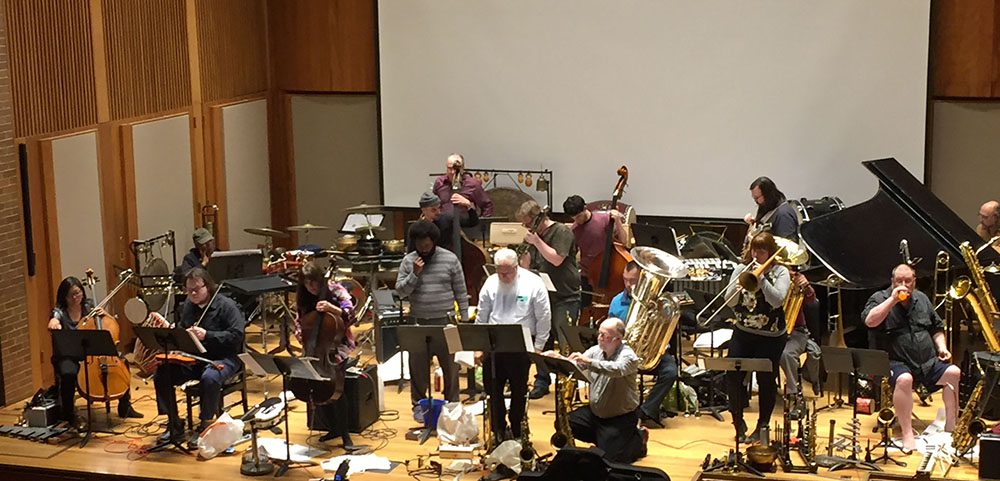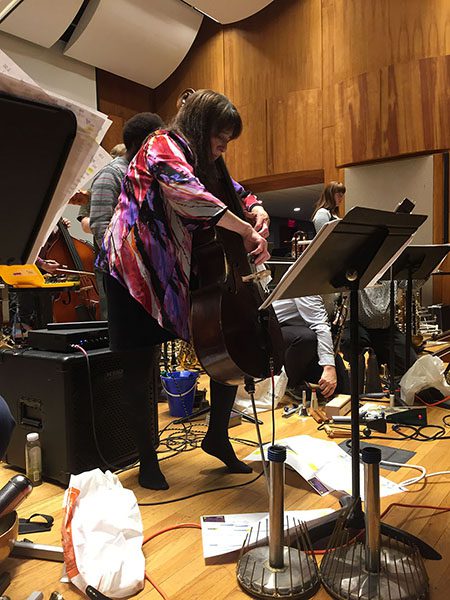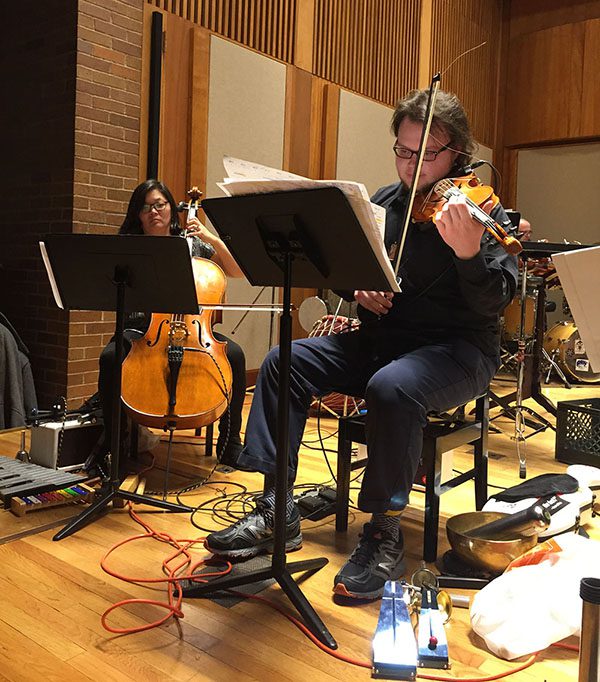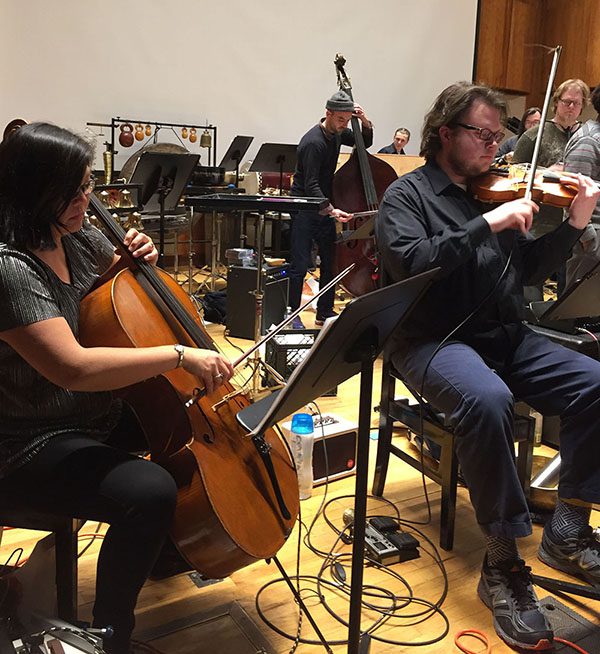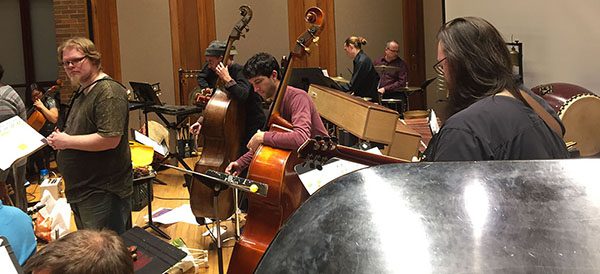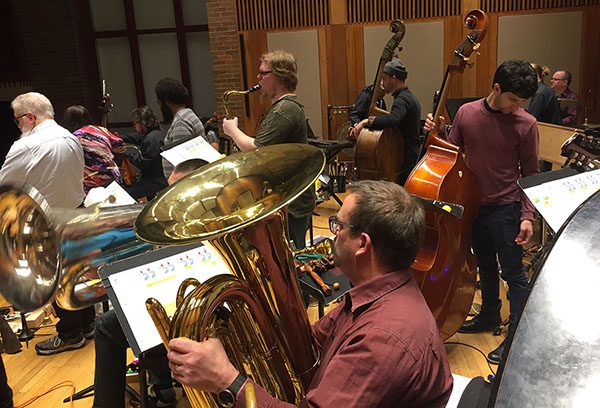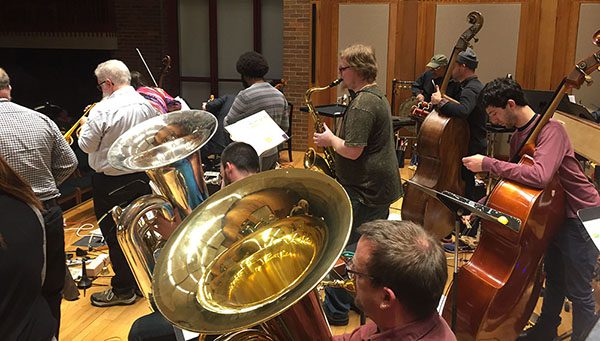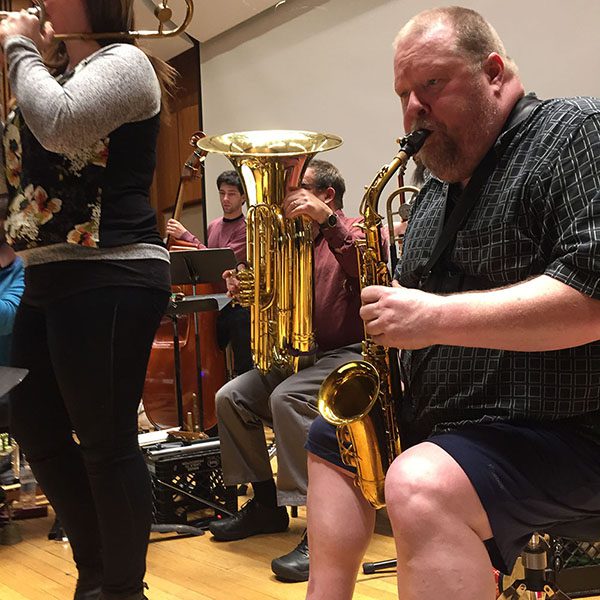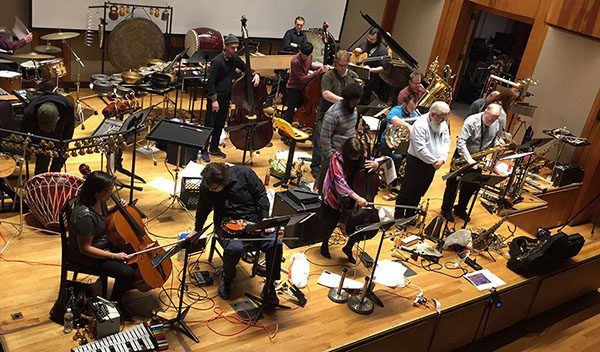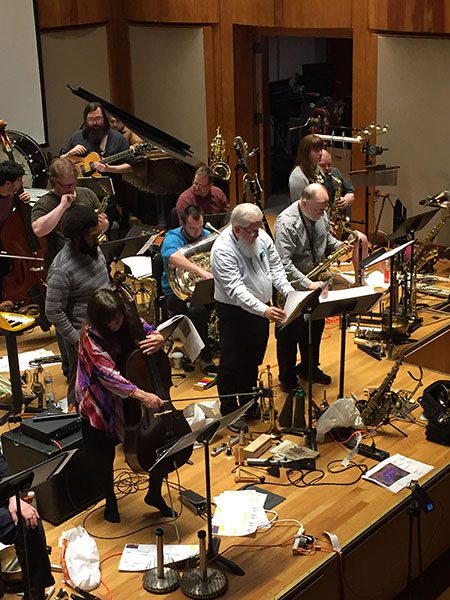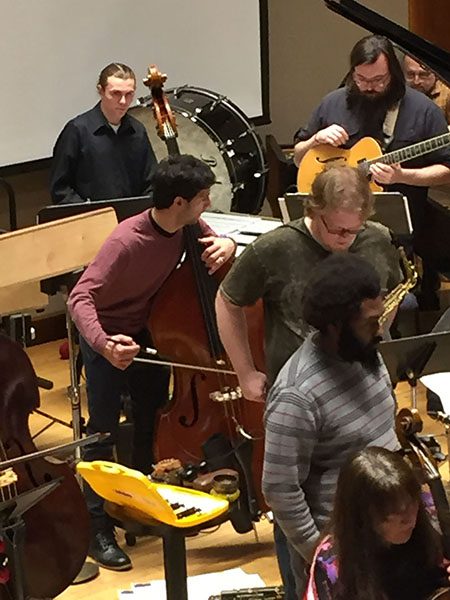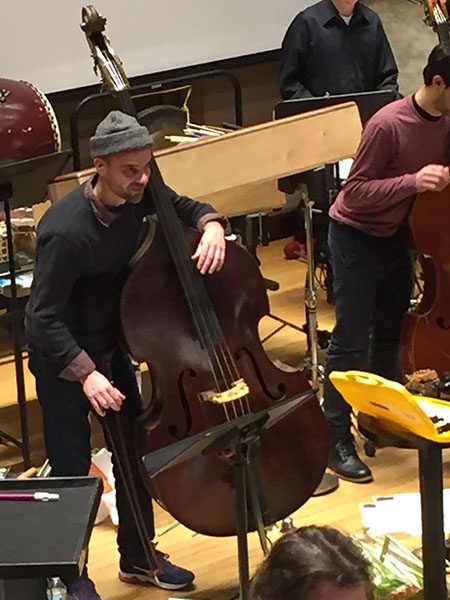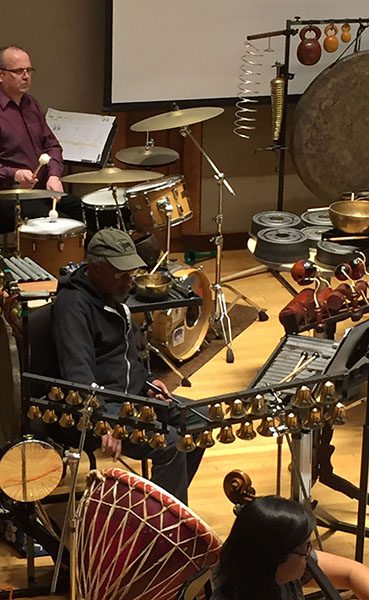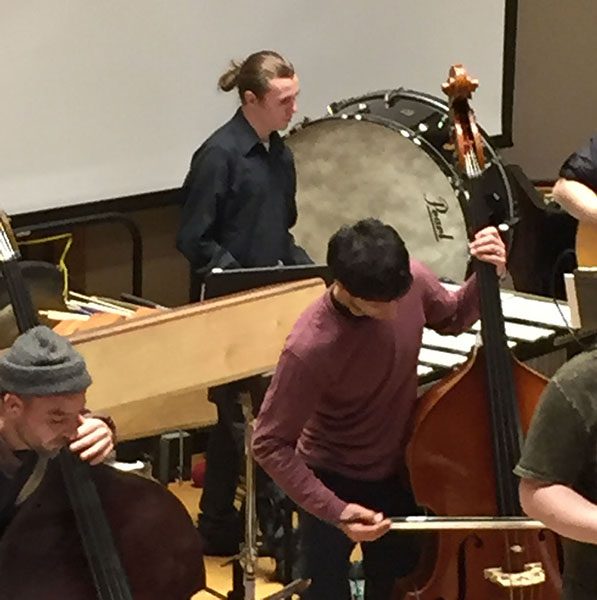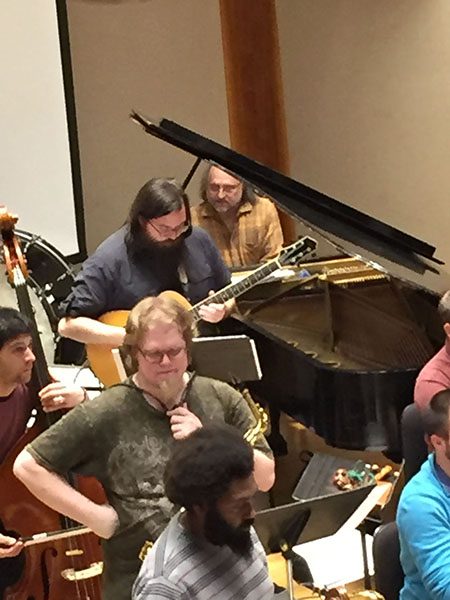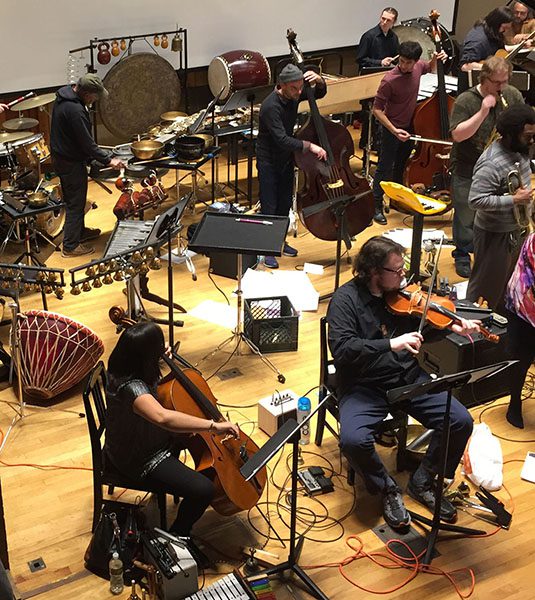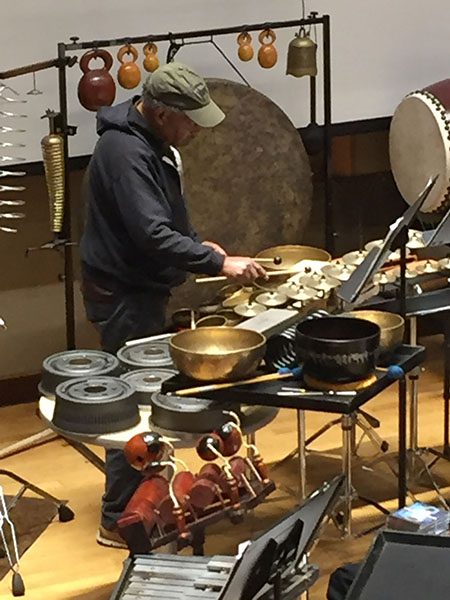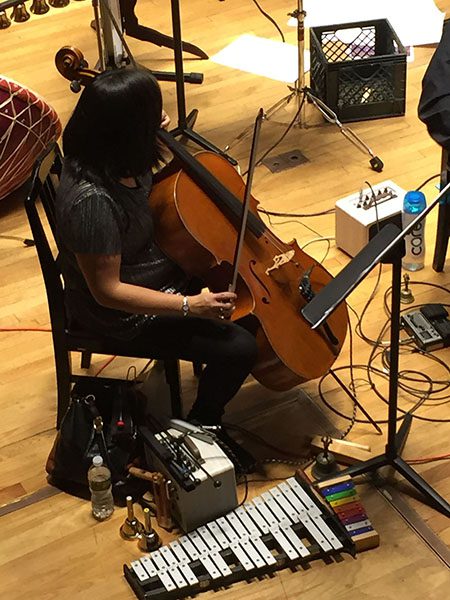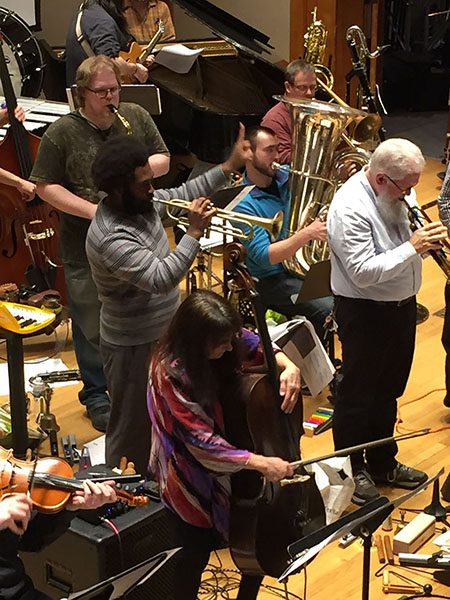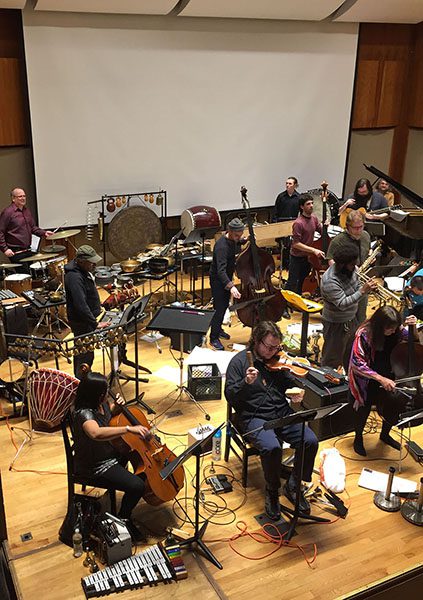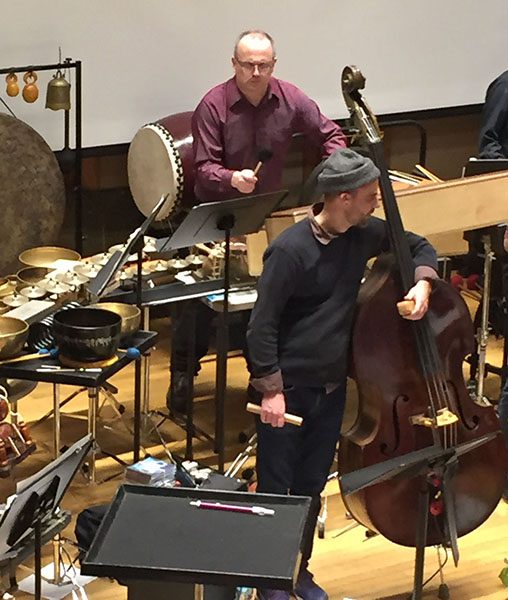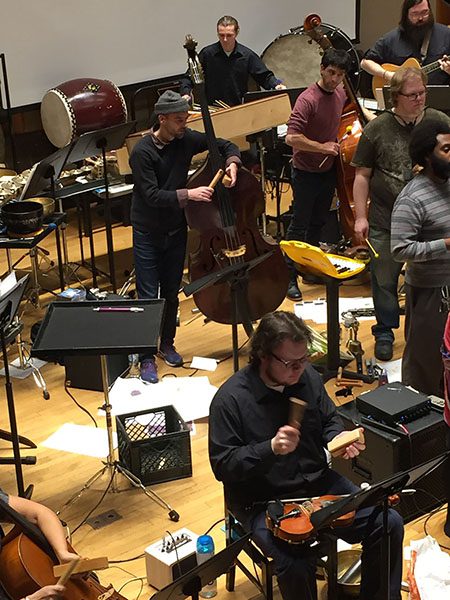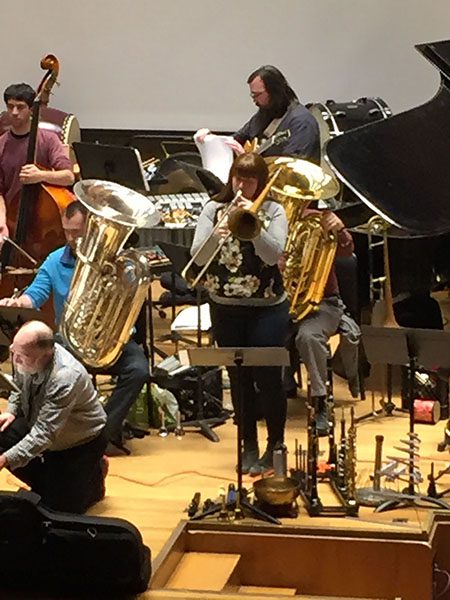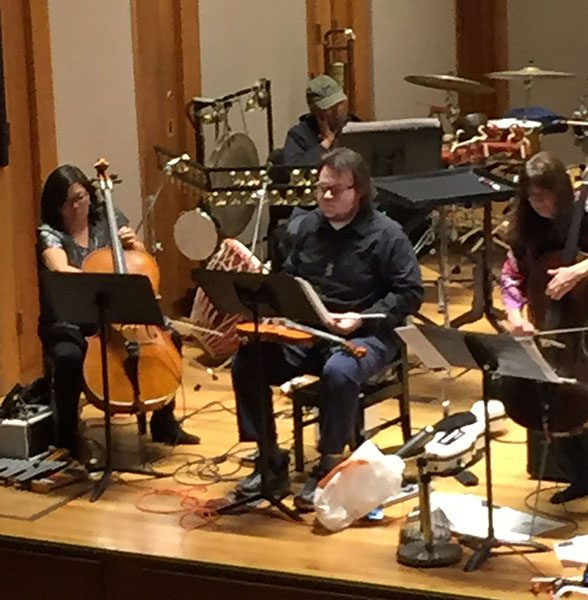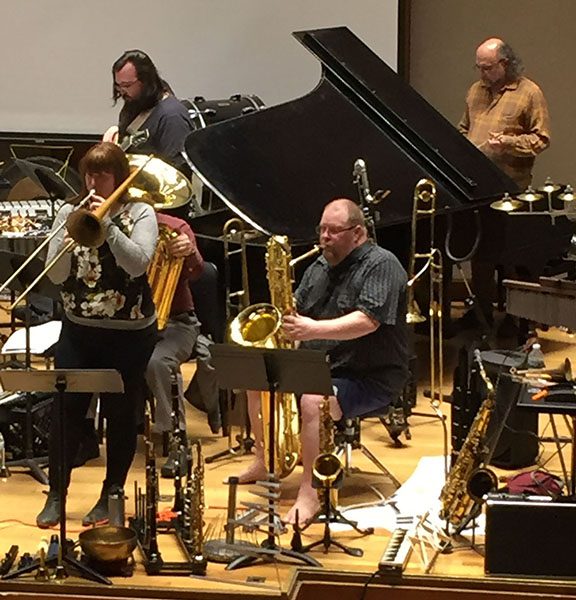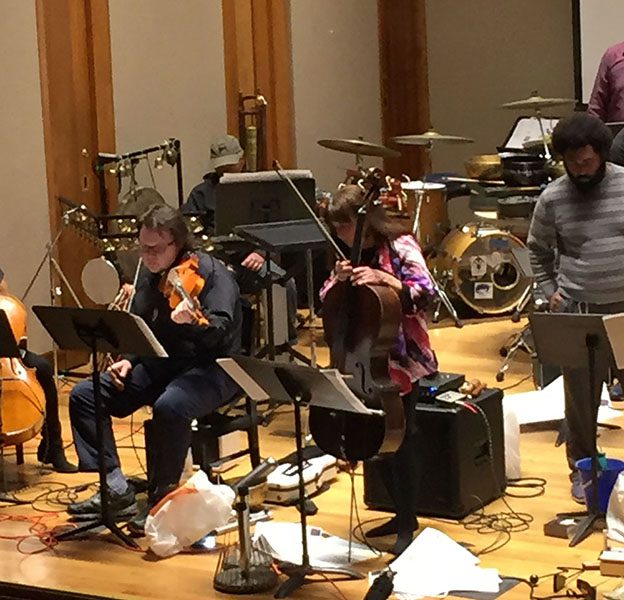Leap of Faith Orchestra
Graphic Scores by PEK
SuperClusters
Excerpt from Karl Ackermann Review
”…SuperClusters appeals on at least two levels; the technical aspects of PEK’s approach are intriguing and thought provoking. From a musical perspective those techniques translate to a listening experience that seems to change with each successive play of the disc…”
Karl Ackermann, AllAboutJazz.com
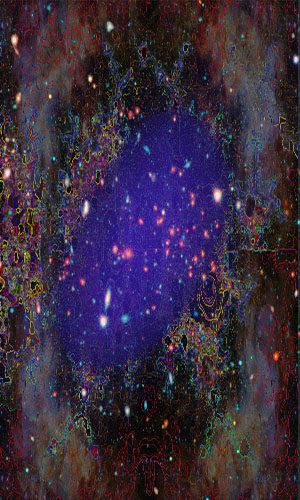
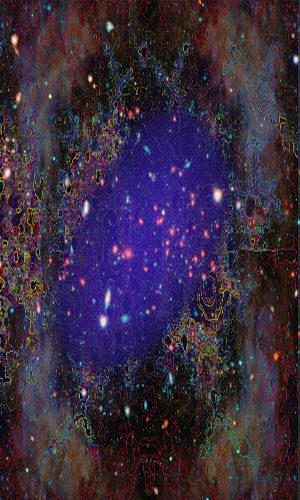
Excerpt from Dave Madden Review
“… Starting with gongs and miscellaneous bangs, cracks and rattles, the one hour and sixteen-minute begins a meander through a busy marketplace of interdependent colors and motions: Some of the big, staccato gestures resemble those from Messiaen’s Chronochromie; others bond together in a flexing wall similar to the climax of Cage’s Atlas Eclipticalis; when all hit at once near the 4:30 mark, there is a warzone reminiscent of Varèse’s Amériques. With a score indicating points of ‘turbulence’ and ‘everyone frenzy,’ cacophony is the best description for this first several minutes and other spots throughout the piece…”
Dave Madden, The Squid’s Ear

Excerpt from Dick Metcalf Review
”… the composition uses a graphic notation system called Frame Notation, and the music they produce is full of power, as well as lots of ‘wide open spaces’ – all executed flawlessly…
… just superb creative effort that will blow your mind.”
Dick Metcalf – Contemporary Fusion Reviews
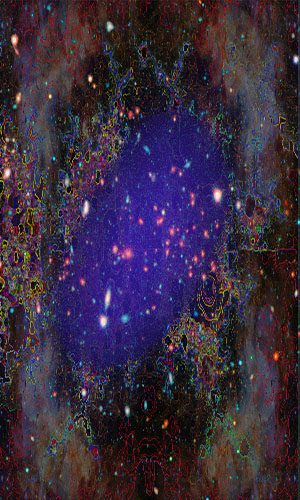

Excerpt from Bruce Lee Gallanter Review
“…Oddly enough, this music is not that chaotic, yes it moves in spurts yet sounds often focused and directed. Considering how many musicians are involved here, there is quite a bit of balanced, thoughtful playing, with skeletal moments amongst the more frenzied sections which rarely last too long before they evolve into something else…”
Bruce Lee Gallanter, Downtown Music Gallery

“… The 4th work using composer, band-leader and multi-instrumentalist David Peck’s Frame Notation Scores for his large ensemble Leap of Faith Orchestra, his graphic notation allowing exceptional, unexpected and truly unusual results in large-scale improvisation, an amazing evolution of the big band concept executed by the some of the finest players in the Boston area; amazing!…”

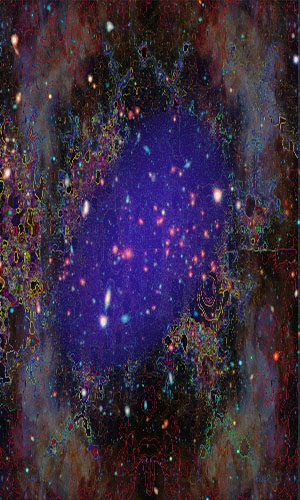
Excerpt From Liner Notes by PEK
“… This system allows me to compose detailed Events without having to notate pitches or rhythms which would require significant rehearsal to accurately achieve. Skilled improvisers, like the ones I have recruited, can easily follow these instructions to create a highly structured improvisation without the need for specific rehearsal even when the ensemble is quite large as it is here. This allows enormous freedom and decision making for each performer and means that we do not have to rehearse these pieces prior to performance. We rely on all of the work of the overall Evil Clown project to tighten the ensembles’ improvisation across its many cross sections while the score provides directions on timing, sonority and transformation.…”
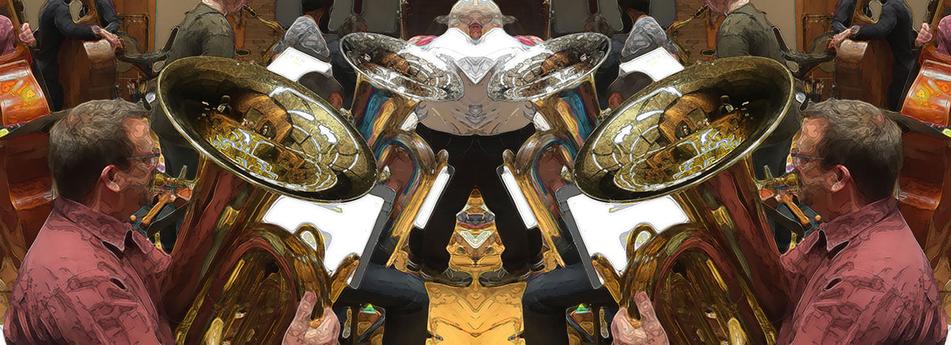
Click on Image of Score
to View the Score

Click on Image of Program
to View the Full Program in pdf
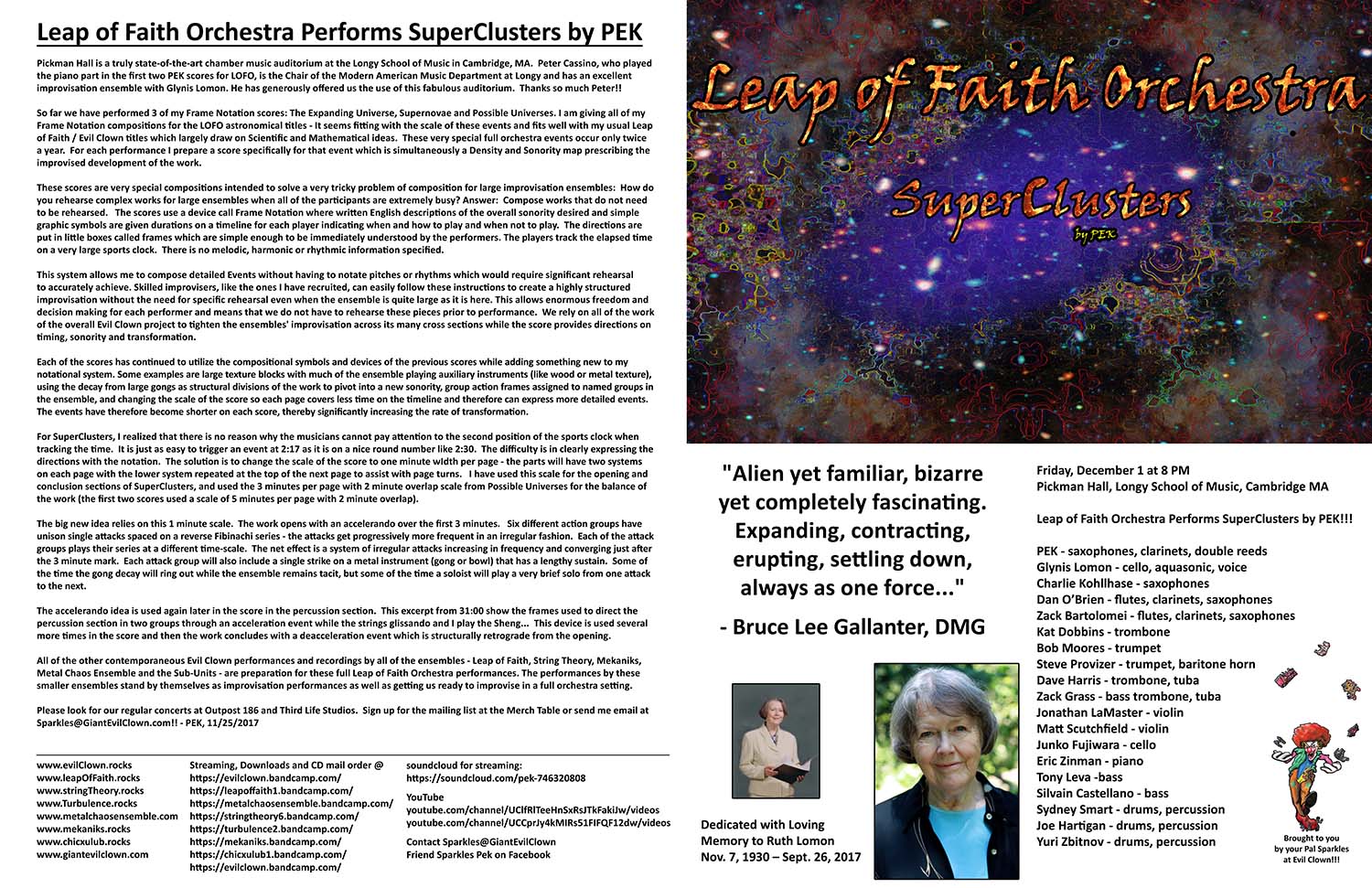
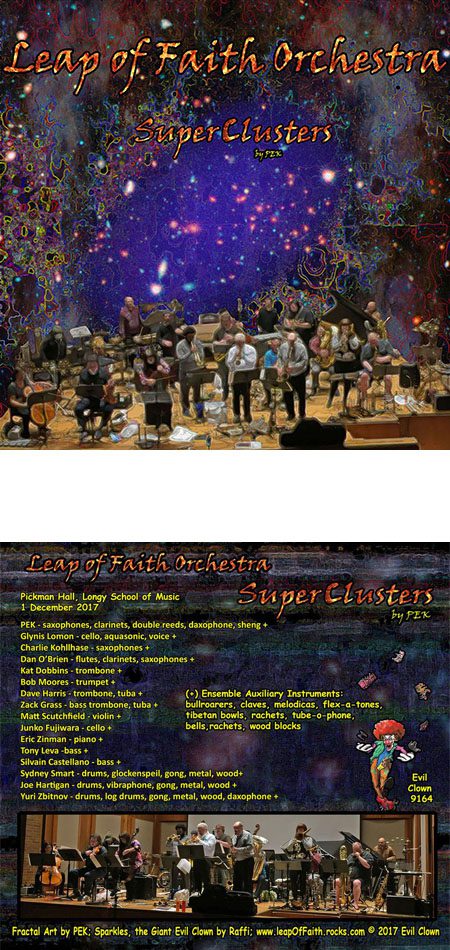
SuperClusters:
Leap of Faith Orchestra
Pickman Hall, Longy School of Music, Cambridge MA – 1 December 2017
1) Leap of Faith – GigaParsecs (download bonus track) – 20:56
PEK – saxophones, clarinets, double reeds, daxophone, sheng +
Glynis Lomon – cello, aquasonic, voice +
Yuri Zbitnov – drums, log drums, gong, metal, wood, daxophone +
Tony Leva – bass +
Syd Smart – drums, percussion +
2) Leap of Faith Orchestra – SuperClusters – 1:16:00
PEK – saxophones, clarinets, double reeds, daxophone, sheng +
Glynis Lomon – cello, aquasonic, voice +
Yuri Zbitnov – drums, log drums, gong, metal, wood, daxophone +
Matt Scutchfield – violin +
Junko Fujiwara – cello +
Charlie Kohlhase – saxophones +
Dan O’Brien – flutes, clarinets, saxophones +
Bob Moores – trumpet +
Forbes Graham – trumpet +
Kat Dobbins – trombone +
Dave Harris – trombone, tuba +
Zack Grass – bass trombone, tuba +
Reverend Grant Beale – guitar, wood +
Eric Zinman – piano, kazoo, slide whistle, wood +
Tony Leva – bass +
Silvain Castellano – bass +
Syd Smart – drums, percussion +
Joe Hartigan – drums, percussion +
(+) Ensemble Auxiliary Instruments:
bullroarers, claves, melodicas, flex-a-tones, bells, tibetan bowls, rachets, tube-o-phone, rachets, wood blocks
Bandcamp | YouTube 1 | YouTube 2 | YouTube Shorties
All About Jazz Review | Squid’s Ear Review | Contemporary Fusion Review
Full Sets
Video Shorties
On two occasions each year, composer and multi-instrumentalist PEK (David M. Peck), gathers together his Evil Clown collective for live recordings. Culled from Leap of Faith, String Theory, Mekaniks, Metal Chaos Ensemble and their respective off-shoots of each, the players form his massive, eighteen-member Leap of Faith Orchestra. For the SuperClusters session, the group assembled at Longy School of Music at Bard College with a specially written score that takes advantage of the individual sub-groups’ previous experiences.
As LOFO had done with their Supernovae (2016) and Possible Universes (2017), SuperClusters entails a single title track composition, here running seventy-six minutes. PEK continues the use of his Frame Notation technique where the score is seen in written descriptions and archetypal symbols within duration bars. The system provides the musicians with instantaneous grasp of their individual performances and an overview of the total piece. Over the course of these large group performances, PEK has tinkered with the technicalities of the process but not the prevailing principle. The piece, though structured by group sections and intervals, is improvised within those parameters.
There are some of the usual array of unconventional “instruments” that PEK favors, such as rachets and flex-a-tones, but in an ensemble of this size, even the most peculiar of them are absorbed into the larger sound. There are few conventional elements in the structure of the composition; melodies are passing shimmers of invention and solos are the exception rather than the rule. Still, there are episodic instances where players and sections stand out -four minutes in, a swirl of brass and horns fills the soundscape, dissipating as quickly as it had formed. At thirteen minutes, Dave Harris’ tuba takes the entire orchestra to a point of near silence that breaks out into a succession of subdivision passages. Among them, is an absorbing percussion solo from Joe Hartigan.
PEK points out, in his album notes, “The performances by these smaller ensembles (those mentioned above) stand by themselves as improvisation performances as well as getting us ready to improvise in a full orchestra setting.” SuperClusters appeals on at least two levels; the technical aspects of PEK’s approach are intriguing and thought provoking. From a musical perspective those techniques translate to a listening experience that seems to change with each successive play of the disc. The digital download of SuperClusters includes a twenty-minute bonus track featuring the smaller Leap of Faith group.
Karl Ackermann, AllAboutJazz.com

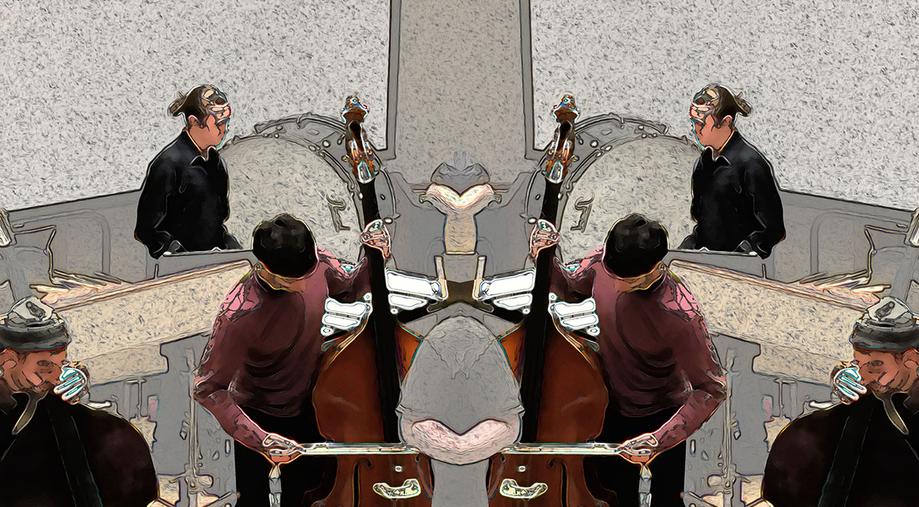

Have you ever listened to an orchestra warm up before a show and thought, “This sounds pretty good”? A number of composers (Weigl, Varèse) have realized this idea, and the results usually baffle most of the audience unless the latter knows what’s happening; it’s like a movie with twenty minutes of introductory narration that makes you ask, “Has the movie begun?”
The decades-old, sixteen-piece Leap of Faith Orchestra relishes in this aesthetic here with a neo-aleatoric approach. Ring leader and multi-instrumentalist (focusing on anything with a reed) PEK aka Dave Pek offers his reasoning behind the choice of artistic independence on the micro level: “How do you rehearse complex works for large ensembles when all of the participants are extremely busy?” Providing a loose score with exact timings and scene changes allows, according to PEK, “…enormous freedom and decision making for each performer and means that we do not have to rehearse these pieces prior to performance.”
Starting with gongs and miscellaneous bangs, cracks and rattles, the one hour and sixteen-minute begins a meander through a busy marketplace of interdependent colors and motions: Some of the big, staccato gestures resemble those from Messiaen’s Chronochromie; others bond together in a flexing wall similar to the climax of Cage’s Atlas Eclipticalis; when all hit at once near the 4:30 mark, there is a warzone reminiscent of Varèse’s Amériques. With a score indicating points of “turbulence” and “everyone frenzy,” cacophony is the best description for this first several minutes and other spots throughout the piece.
“Whimsy” should also be added when mentioning SuperClusters. For every finger wag of “Academic” seriousness, there is a slinky jazz lick, Looney Toons joke (the work ends with a flurry of kazoo-like buzzes and someone yelling “SuperClusters!”), heavy-fisted piano mashing, and brief musical quote (I think I heard Donna Summer’s “On the Radio”) just around the bend — all sometimes overlapping. Charles Ives’ “two orchestras crash into one another” has nothing on these folks.
Though remarkable for the display of volume and amplitude (particularly during a passage of lugubrious unison of low brass and strings), the more fascinating moments of the work involve solos and smaller groupings of instruments (the accompanying bonus download, GigaParsecs, excels at this) — and being able to focus on smaller bites of this elephant. For example, near 12:30, Pek, cellist / vocalist / hydrophonist Glynis Lomon and drummer Yuri Zbitnov engage in a gnashing set of slow motion, wide pitch dips and bends, polyrhythmic log drum percussion and furious bow work. At 21:00, sultry saxophone purrs over a maniacal series of wooden clacks. Electric guitar static provides a static sound scape under Eric Zinman’s keyboard flight. As a bell literally sounds near the 48-minute mark, the thunder storm stops on a dime in favor of gentle metallic taps, spittled mouth piece squeaks, Dave Harris’s stomping tuba line, and a crucial element: pause. With such a furious, grandiose scale, silence is striking in SuperClusters.
(Side note: I’m only listing a few band members as I read them on the score. Forgive me, all players not mentioned. If I were to list all your collective accomplishments, the text would fill the pages of Genesis.)
While researching the best way to tune an orchestra, you won’t find many examples of “just play.” One online forum participant, frustrated with her high school orchestra writes, “My warm-up routines need a shot of adrenaline!” Another asks, “Are there any other ways that I can make my warm-up segment more engaging? Do you think that improvisation can be used as a part of warm-ups? Any ideas for how to incorporate something like that?”
See above…
Dave Madden, The Squid’s Ear
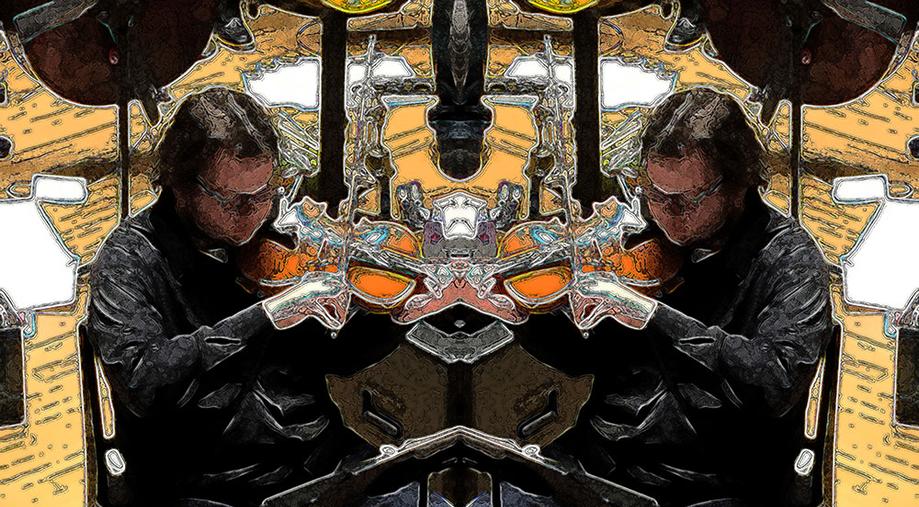
Leap of Faith Orchestra brilliantly bizarre improvised ensemble Leap of Faith Orchestra – SUPER CLUSTERS: I want to say I’m amazed by the discoveries a day can bring… OTOH, though, I’ve been in a constant state of amazement since I emerged from the womb… LOFO is the source of my current wonder, no doubt… the composition uses a graphic notation system called Frame Notation, and the music they produce is full of power, as well as lots of “wide open spaces” – all executed flawlessly, as you’ll witness in the video.
…if you aren’t blown away by their performance at Pickman Hall at the Longy School of Music in Cambridge, MA, you more than likely listen to “middle of the road” music all day long. Just kidding, you wouldn’t be here at our magazine unless you wanted to see and hear music that challenges the mind as well as the spirit. The player list is far too long, so check it out on the BandCamp page linked in below.
A preview of the album is available on their BandCamp site, and if you’re even slightly interested in sonic adventure, I would encourage you to do the pre-order on that page right away. Also, if you’re as big a fan of improvised music as I am, you will want to visit their main page on BandCamp, too, where you’ll find a whole host of other performances available.
As you will hear, this is truly improvised music… the frame notation uses graphic symbols to evoke different moods and timbres as the clock (they are watching) progresses through the piece… my friends Davey Williams, LaDonna Smith and Harlan Mark Vale would just love this music, as do I. The intricate weave of bells and gongs into the “attack groups”, as they’re called, epitomizes “creativity on the go”, and is both refreshing and intriguing.
I give Leap of Faith Orchestra a MOST HIGHLY RECOMMENDED, as well as an “EQ” (energy quotient) rating of 4.99… just superb creative effort that will blow your mind. Get more information on their BandCamp page for the release. Rotcod Zzaj
Dick Metcalf – Contemporary Fusion Reviews



Bruce Lee Gallanter Review
LEAP OF FAITH ORCHESTRA With PEK / GLYNIS LOMON / CHARLIE KOHLHASE / ERIC ZINMAN / YURI ZBITNOV / SYDNEY SMART / JOE HARTIGAN / et al – Super Clusters (Evil Clown 9164; USA) This is the fourth major work for the Leap of Faith Orchestra, all of which are based on Dave Peck’s Frame Notation scores. These pieces are not rehearsed since it would nearly impossible to do this, although Mr. Peck has found a way to use relatively simple directions for the many members of the orchestra. Each of the four large works have utilized compositional devices and symbols, adding new devices with each new score. As a longtime fan of big bands or large ensemble music, I am often fascinated by the way certain composers & bandleaders have organized & conducted their ensembles. From the Duke Ellington & Count Basie Orchestras through Stan Kenton, Frank Zappa’s Grand Wazoo and the Globe Unity Orchestra, I am always searching for more of this music to check out. Our newsletter (04/13/2018) started off with a new disc from the Globe Unity Orchestra, called ’50 Years’, a half century since their first recording. In a few years it will be a century since the beginning of the Duke Ellington Orchestra in the 1920’s!?!
As I listen to the new disc, ’SuperClusters’ by the Leap of Faith Orchestra, I am listening to how large ensemble music has evolved over nearly a century. Leap of Faith are less than a decade old and have recorded every performance with upwards of 100 CD’s so far. There are 16 members for this session, which includes the core members like PEK, Glynis Lomon & Yuri Zbitnov plus occasional members like Eric Zinman on piano and Sydney Smart on drums. This disc was recorded live at Pickman Hall, outside of Boston, on December 1st of 2017. Oddly enough, this music is not that chaotic, yes it moves in spurts yet sounds often focused and directed. Considering how many musicians are involved here, there is quite a bit of balanced, thoughtful playing, with skeletal moments amongst the more frenzied sections which rarely last too long before they evolve into something else. Unless you live in the Boston area or perhaps find your way to DMG for a once a year set, you will most likely have a chance to check out Leap of Faith live/ So, you should check out their discs, perhaps 1 or 2 at a time.
Bruce Lee Gallanter, Downtown Music Gallery
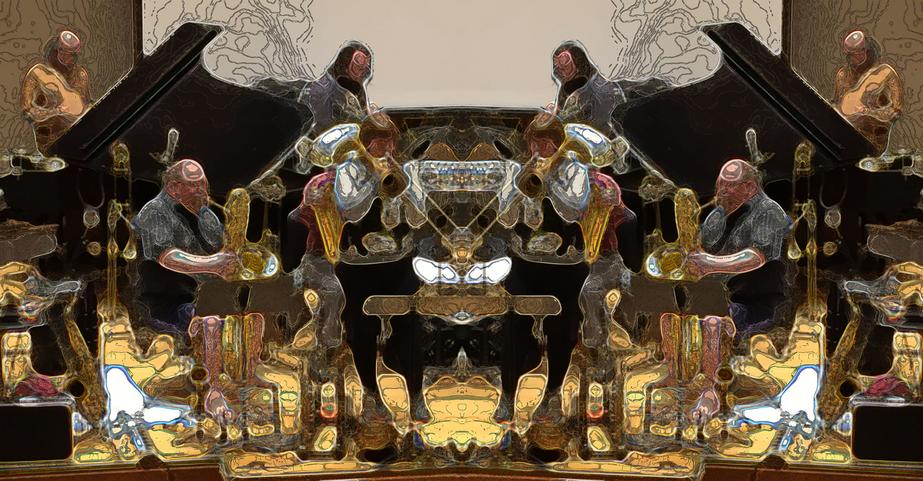
Liner Notes by PEK
Pickman Hall is a truly state-of-the-art chamber music auditorium at the Longy School of Music in Cambridge, MA. Peter Cassino, who played the piano part in the first two PEK scores for LOFO, is the Chair of the Modern American Music Department at Longy and has an excellent improvisation ensemble with Glynis Lomon. He has generously offered us the use of this fabulous auditorium. Thanks so much Peter!!
We have now performed 4 of my Frame Notation scores: SuperClusters, The Expanding Universe, Supernovae and Possible Universes. I am giving all of my Frame Notation compositions for the LOFO astronomical titles – It seems fitting with the scale of these events and fits well with my usual Leap of Faith/ Evil Clown titles which largely draw on Scientific and Mathematical ideas. These very special full orchestra events occur only twice a year. For each performance I prepare a score specifically for that event which is simultaneously a Density and Sonority map prescribing the improvised development of the work.
These scores are very special compositions intended to solve a very tricky problem of composition for large improvisation ensembles: How do you rehearse complex works for large ensembles when all of the participants are extremely busy? Answer: Compose works that do not need to be rehearsed. The scores use a device call Frame Notation where written English descriptions of the overall sonority desired and simple graphic symbols are given durations on a timeline for each player indicating when and how to play and when not to play. The directions are put in little boxes called frames which are simple enough to be immediately understood by the performers. The players track the elapsed time on a very large sports clock. There is no melodic, harmonic or rhythmic information specified.
This system allows me to compose detailed Events without having to notate pitches or rhythms which would require significant rehearsal to accurately achieve. Skilled improvisers, like the ones I have recruited, can easily follow these instructions to create a highly structured improvisation without the need for specific rehearsal even when the ensemble is quite large as it is here. This allows enormous freedom and decision making for each performer and means that we do not have to rehearse these pieces prior to performance. We rely on all of the work of the overall Evil Clown project to tighten the ensembles’ improvisation across its many cross sections while the score provides directions on timing, sonority and transformation.
Each of the scores has continued to utilize the compositional symbols and devices of the previous scores while adding something new to my notational system. Some examples are large texture blocks with much of the ensemble playing auxiliary instruments (like wood or metal texture), using the decay from large gongs as structural divisions of the work to pivot into a new sonority, group action frames assigned to named groups in the ensemble, and changing the scale of the score so each page covers less time on the timeline and therefore can express more detailed events. The events have therefore become shorter on each score, thereby significantly increasing the rate of transformation.
For SuperClusters, I realized that there is no reason why the musicians cannot pay attention to the second position of the sports clock when tracking the time. It is just as easy (for the performers) for me to trigger an event at 2:17 as it is on a nice round number like 2:30. The difficulty is in clearly expressing the directions with the notation. The solution is to change the scale of the score to one minute width per page – the parts will have two systems on each page with the lower system repeated at the top of the next page to assist with page turns. I have used this scale for the opening and conclusion sections of SuperClusters, and used the 3 minutes per page with 2 minute overlap scale from Possible Universes for the balance of the work (the first two scores used a scale of 5 minutes per page with 2 minute overlap).
The big new idea relies on this 1 minute scale. The work opens with an accelerando over the first 3 minutes. Six different action groups have unison single attacks spaced on a reverse Fibonacci Series – the attacks get progressively more frequent in an irregular fashion. Each of the attack groups plays their series at a different time-scale. The net effect is a system of irregular attacks increasing in frequency and converging just after the 3 minute mark. Each attack group will also include a single strike on a metal instrument (gong or bowl) that has a lengthy sustain. Some of the time the gong decay will ring out while the ensemble remains tacit, but some of the time a soloist will play a very brief solo from one attack to the next.
The accelerando idea is used again later in the score in the percussion section. This excerpt from 31:00 show the frames used to direct the percussion section in two groups through an acceleration event while the strings glissando and I play the Sheng … This device is used several more times in the score and then the work concludes with a deacceleration event which is structurally retrograde from the opening. All of the other contemporaneous Evil Clown performances and recordings by all of the ensembles – Leap of Faith, String Theory, Mekaniks, Metal Chaos Ensemble and the Sub-Units – are preparation for these full Leap of Faith Orchestra performances. The performances by these smaller ensembles stand by themselves as improvisation performances as well as getting us ready to improvise in a full orchestra setting. Please look for our regular concerts at Outpost 186 and Third Life Studios. Sign up for the mailing list at the Merch Table or send me email at dmpeck@sgh.com !!
– PEK, 11/25/2017

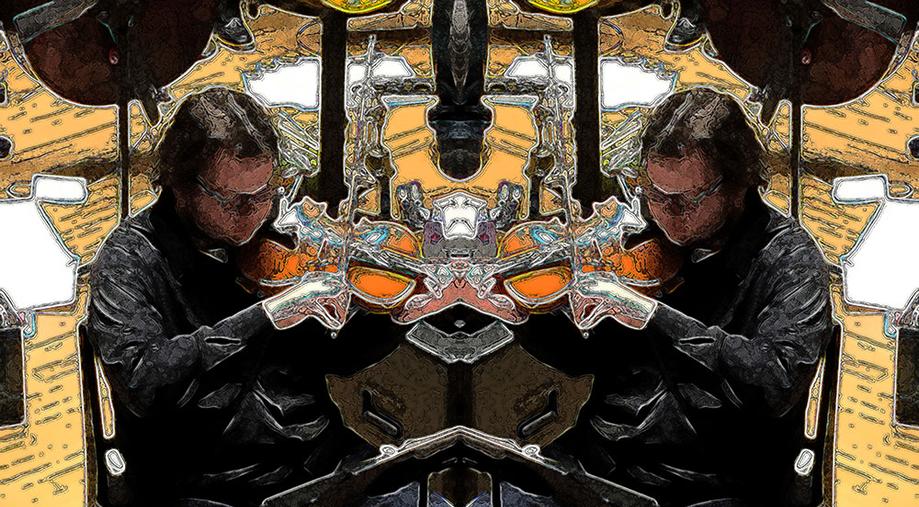
Raffi Photos
